Table of Contents
A laboratory furnace was developed for use in studying the interrelationships among variables associated with skull melting and casting high-temperature metals. Although additional work is necessary to determine the extent to which the information obtained by using this furnace can be extrapolated to larger furnaces of the same type, many casting characteristics of metals and alloys can be determined on equipment of this size.
This furnace is a laboratory-size, consumable-electrode, skull-casting furnace equipped with a water-cooled copper ladle. The ladle, which is a tilt-pour or over-the-lip type, has a volume of approximately 30 cubic inches and provides up to 20 cubic inches of molten metal for castings. Castings of various reactive and refractory metals, including zirconium, titanium, hafnium, columbium, molybdenum, tantalum, and tungsten, have been produced. In addition, castings of iron, chromium, and copper have been made. The simplicity and versatility of the apparatus would make it useful to metallurgical laboratories preparing cast specimens.
The feasibility of producing castings of refractory metals by the consumable-electrode arc process was first investigated by the Bureau of Mines at Albany, Oreg., late in 1953. Research indicated that as much as 60 percent of a consumable-electrode, arc-melted ingot remained molten during the melt. The first attempts to transfer the molten metal to a mold were made by bottom-pour techniques.
A standard ingot furnace was modified to include a water-cooled copper plug in the bottom of the crucible which could be withdrawn for pouring. Although many successful castings were produced with equipment of this type, the uncertainty of controlling the casting operation led the Bureau to use an over-the-lip design.
The first over-the-lip furnace was built with a 6-inch-diameter ladle, which later was replaced with an 8-inch-diameter ladle. This furnace had a pouring capacity of about 26 pounds of titanium, and the success of its operation encouraged the construction of larger furnaces. Three larger over-the-lip furnaces were built and successfully operated. One of these furnaces, used at Albany for producing shaped castings, has provisions for interchangeable ladles which range from 8 to 11 inches in diameter. The smaller ladle has a capacity of approximately 300 cubic inches, and the larger ladle has a capacity of approximately 1,345 cubic inches.
Description of Melting Furnace
Figure 1 is a view of the laboratory-scale casting furnace, and figure 2 is a schematic cross section. The water-cooled ladle chamber (10) and the mold chamber (11) were originally designed to fit the body of an existing, 4-inch ingot furnace, thus utilizing the existing vacuum system and controls for the casting operation. Numerous modifications have been made to the furnace since it was installed, but its design is still such that it is an adaptation of a standard ingot furnace.
Figure 3 is a cross section of the ladle, the ladle chamber, and the mold chamber. The inner wall of the ladle chamber is a 7-¼-inch length of 9-inch copper pipe; the outer wall is an equal length of standard 10-inch copper pipe. The two walls are joined at the ends
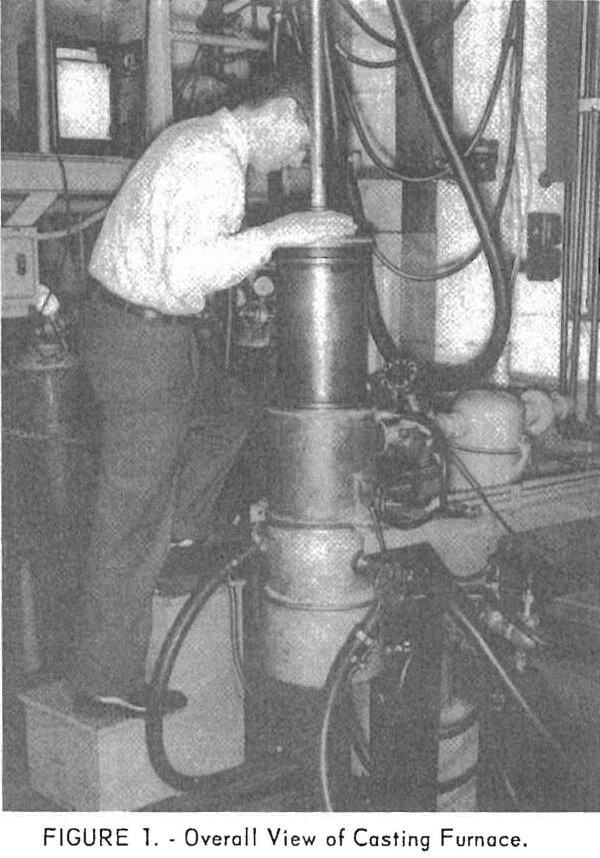
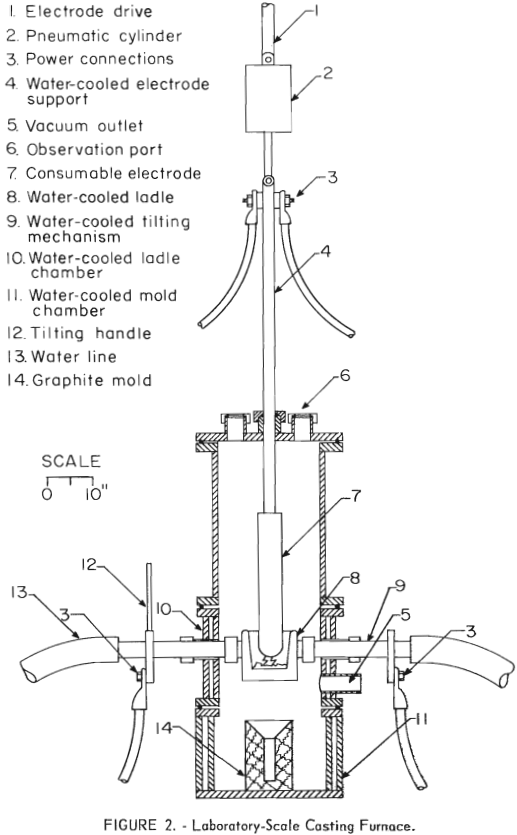
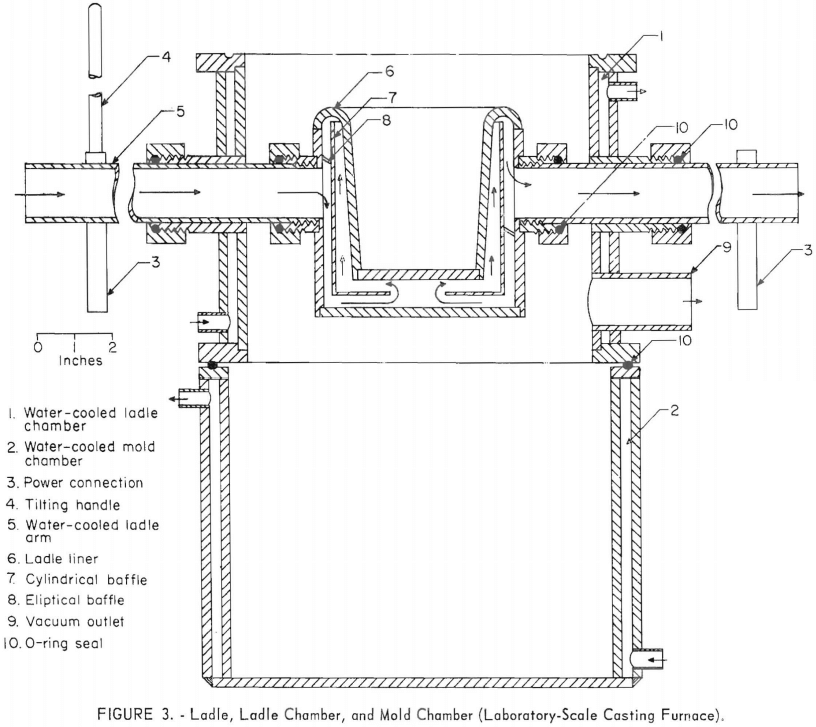
with flanges of ½-inch copper plate. Inlet and outlet fittings for the cooling water are standard 5/8-inch water-hose fittings brazed to holes in the outer jacket. These fittings are 1 inch above and below the bottom and top flanges, respectively. The two openings for the ladle arms are 180° apart and 3-½ inches below the top flange. Two-inch lengths of standard 1-½-inch copper pipe are threaded on the outer end to accommodate brass nuts for effecting an O-ring seal, as shown in the figure. The standard 1-¼-inch copper pipe used for the ladle arms fits easily within these ports.
Details of the ladle design are also included in figure 3. The ladle is supported on two 12-inch lengths of standard 1-¼-inch copper pipe (5) which serve as the electrical connections to the ladle and the inlet and outlet for cooling water. One end of each arm is threaded, and the arm is screwed into the ladle to provide the mechanical and electrical connection. These arms are the supporting members for the ladle and are free to rotate within the ports of the ladle chamber when the ladle is tipped. An O-ring provides the vacuum seal between the water flowing in the ladle and the interior of the furnace.
The outer wall of the ladle is a 4-¾-inch length of standard 5-inch copper pipe with a ¼-inch copper plate brazed on the bottom. The sockets for the arms are machined from 2-½-inch copper rod. The two arms insure good electrical contact by tightening against a shoulder machined on the inner surface of these sockets.
The inner liner (6) is fabricated from a length of standard 3-inch copper pipe. The lip of the liner is spun so that the brazed joints are not exposed to the arc during melting. The ladle is 4 inches deep, and the sidewalls are tapered from approximately a 3-inch diameter at the bottom of the ladle to a 3-½-inch diameter at the top. This taper facilitates removal of the skull from the ladle after a heat. The bottom is ¼-inch copper plate brazed in position. These liners must be replaced frequently when working with high-temperature metals. No problem has been encountered in machining the brazed joint between the lower surface of the lip and the outer wall of the ladle in order that new liners can be installed.
Experience in producing the inner liners has shown the following procedure to be the most satisfactory. A length of 3-inch pipe sufficient to produce several liners is mounted in a lathe, and the lip for one liner is spun. A length sufficient for one liner is then removed, and the lip for a second ladle is spun. In this way, heating the end to be spun does not soften the end of the pipe held in the lathe chuck as it would if the pipe stock were cut to length before spinning the lip. Following the spinning operation, a steel mandrel is pressed into the partly completed liner to form the tapered sides. This operation is performed cold. The raw edges of the liner are then machined, and the bottom is brazed in position.
Arrows in figure 3 indicate the coolant flow through the ladle. Water enters one arm of the ladle and is directed by baffles (7, 8) so that it impinges on the bottom surface of the inner liner and flows upward along the liner walls. The elliptical baffle is set at an angle with the centerline of the arms, so that it is above the inlet arm and below the outlet arm. This baffle forces the inlet water downward between the cylindrical baffle and the outer wall of the ladle, and on the outlet side it directs the water out the opposite arm. The opening between the baffle and the inner surface of the spun lip is held to approximately one-eighth inch to assure adequate coolant flow at this critical part of the ladle.
The mold chamber, located directly below the ladle, is a double-walled steel chamber with an inside diameter of 10 inches and a depth of 8 inches.
The chamber provides enough space for molds used in most of the research work using this furnace; however, a larger chamber would be desirable for molds required for the production of small, shaped castings.
The copper electrode shaft consists of two coaxial copper pipes which permit end-to-end circulation of cooling water. Water, which enters at the top, flows through the inner pipe to the bottom of the electrode shaft, then upward between the inner and outer pipes to the top of the shaft where it is exhausted. Flexible, water-cooled power leads are bolted to the upper end of the electrode shaft for the cathodic connection of the electrical power circuit.
The power supply for the furnace consists of 18 selenium rectifiers connected in parallel. Open-circuit voltage for the network is 70. Arc current available to the furnace is limited to 8,000 amperes by the shunt used for metering. The arc current can be controlled from a minimum of 200 amperes to the maximum by motor-driven tap changers.
A 5-horsepower vacuum pump with a capacity of 110 cubic feet per minute produces an ultimate furnace vacuum of 15 microns with a leak rate of less than 3 microns per minute. This pump is more than ample for the system.
Melting Furnace Operation
The melting and casting operation begins with the selection and fabrication of an electrode. Castings have been made using electrodes prepared from sponge, scrap turnings, sintered powder, sintered and forged powder, and previously melted material. Electrodes with a very small cross section and those fabricated from material containing volatiles result in a low ratio of the metal poured to the metal melted. Electrodes fabricated from pressed bars of sponge metal containing large amounts of residual salts and from iron containing appreciable quantities of dissolved gases result in a particularly low ratio.
A ¾-inch male thread is machined on one end of the electrode stock. For material that cannot be machined, a suitable stub of metal with this thread is welded to one end. The thread screws into the water-cooled copper shaft and provides the mechanical and electrical connection between the shaft and the electrode. It is important to machine a square shoulder on the electrode so that good metal-to-metal contact is made between the electrode and the shaft, thereby assuring an efficient electrical connection.
The length of the electrode is determined by the length the furnace body will accommodate and the amount of metal required for the castings. A 2-inch- diameter electrode 20 inches long will provide ample metal for a series of three or four runs and can be accommodated easily by the furnace described.
For all heats it is necessary to provide a starting pad in the bottom of the ladle on which to initiate the arc. If the skull from a previous melt is available it is placed in the ladle, and a few chopped turnings are placed in the bottom of the skull to facilitate striking the arc without having it adhere to the skull. Figure 4 shows the ladle with a skull in position. When no skull is available, more turnings are placed in the bottom of the ladle to serve as a starting pad. The amount varies with the metal being melted, but usually it should be sufficient to cover the bottom of the ladle to a depth of approximately half an inch. For example, heats of titanium and zirconium are started with 150 grams of base, whereas heats of tantalum require 450 grams (the densities of zirconium and tantalum are respectively 6.5 and 16.6 grams per cubic centimeter).
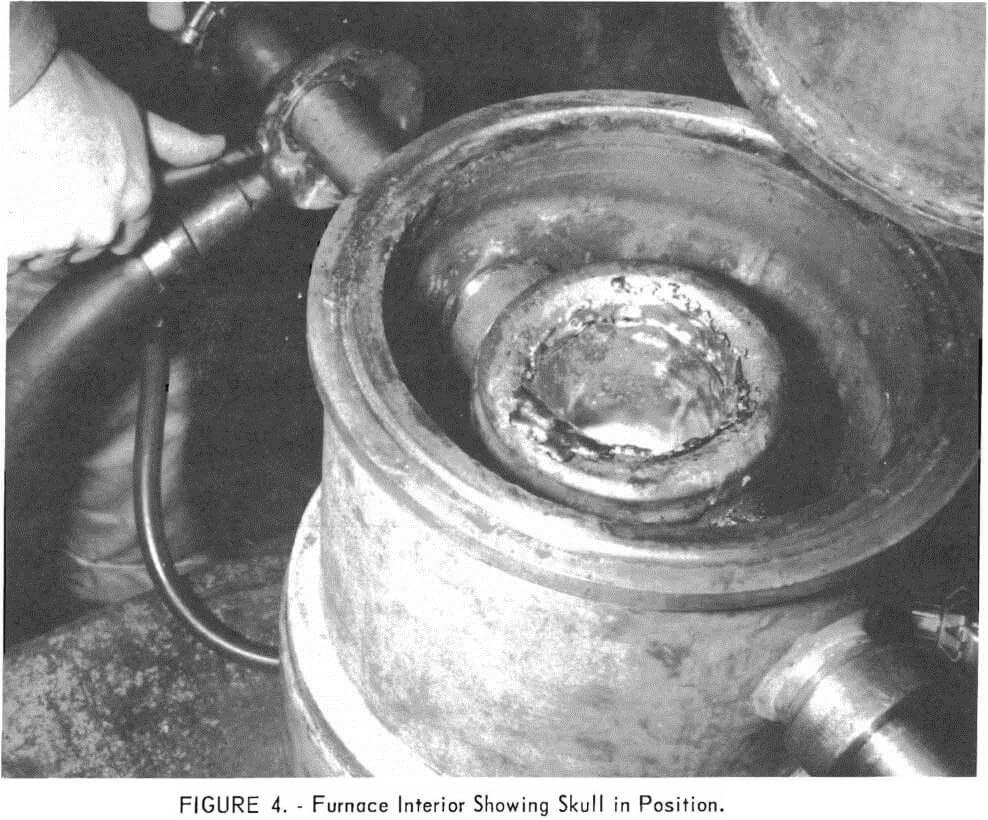
When the electrode and base have been loaded into the furnace and the molds placed in position, the furnace is closed and evacuated. Most metals are melted and cast with the furnace evacuated to the ultimate vacuum of the system at the beginning of the heat and with the vacuum valve of the furnace open throughout the run. The thermocouple gage, located in the vacuum line between the furnace and the main furnace valve, normally indicates an absolute pressure of 150 to 500 microns during the heat. The casting of chromium provides an exception to the practice of operating in the micron range. The high vapor pressure of chromium makes it necessary to melt it in a pressure of about one-third of an atmosphere of helium. This practice would be necessary for other metals with high vapor pressure and with alloys when one or more of the alloy additions has a high vapor pressure.
When the proper furnace pressure has been attained, the electrode is lowered until an arc is initiated between the electrode and the starting pad. Starting electrical power requirements vary with the metal but should be high enough to melt the starting pad and low enough to prevent rupture of the ladle. A typical starting arc current for a zirconium melt would be approximately 1,500 amperes. Typical values for arc current and the potential for various metals are given in tables 1, 2, and 3.
As soon as the base has been consolidated into a molten pool, the power is raised to the desired level. The electrode is fed downward by a motor-driven rack and pinion as it is consumed, so that a uniform arc potential is maintained. When the required quantity of metal has been melted, the arc is terminated. This quantity can be determined by observing the melting of a pin placed at a predetermined point on the electrode or by watching the level of the molten metal in the ladle. The instant the arc is terminated the electrode is withdrawn from the ladle by the air cylinder mounted in the electrode drive mechanism. This cylinder is actuated by a hand lever near the pouring station. The ladle is then tipped, and the contents are poured into the mold. The entire operation from the time the arc is extinguished until the metal is poured generally is completed in 2 seconds.
After the pour, the furnace is allowed to recover to a pressure approaching the ultimate attainable and is backfilled with helium to an absolute pressure of 15 inches of mercury.. This speeds cooling and helps prevent contamination of the hot metal. Cooling time ranges from 20 to 30 minutes.
Tables 1 through 3 summarize the results of several typical runs. In general, maximum casting efficiency results from a proper balance of electrical power and water cooling; however, other factors, such as electrode composition and arc potential, also influence the casting efficiency. Casting efficiency, as used in this report, refers to the ratio of the weight of metal poured to the weight of the total charge (weight of electrode melted plus weight of skull or base). For metals with higher melting points, higher power levels and increased coolant flow are required.
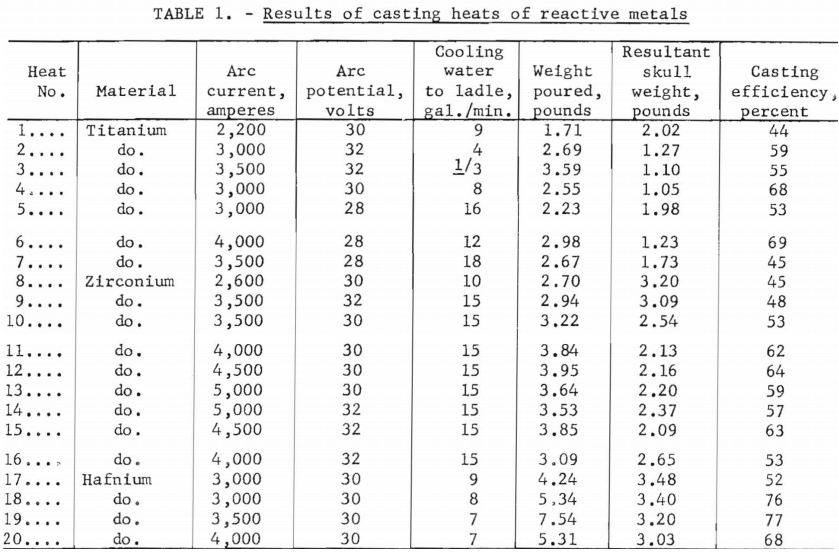
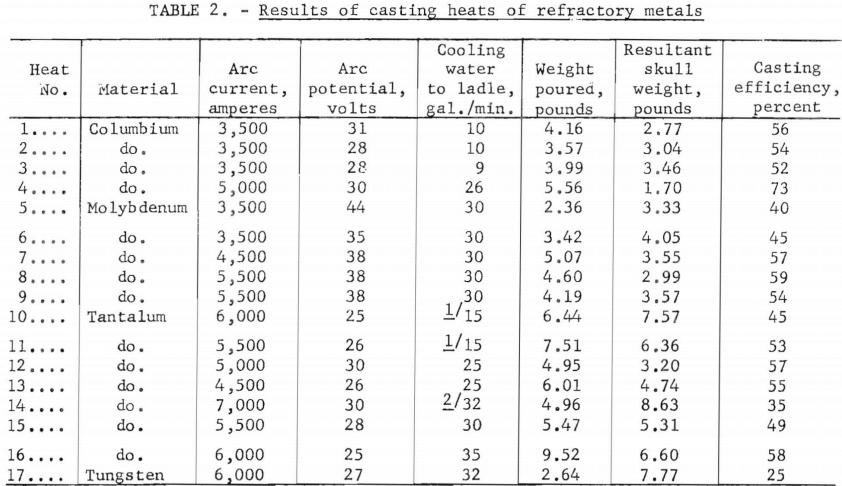
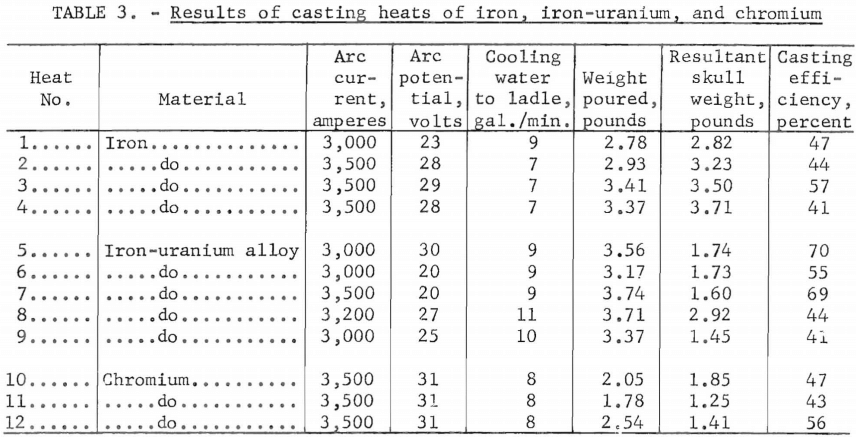
Operation With Specific Metals
The following paragraphs briefly outline the results for the various metals melted in this furnace. In addition to the work with individual metals described in subsequent paragraphs, research has been conducted on the relationship of the operating variables to skull casting. Fluidity spirals, similar to those shown in figures 5, 6, and 7, have been cast to determine the effects of arc current, arc potential, and coolant flow to the ladle. These variables affect casting efficiency and the fluid life of the metal, measured by the length of the fluidity spiral. Data are insufficient to draw conclusions as to the interrelationship of these variables; however, the values stated for the arc current, arc potential, and coolant flow for each of the following metals have been found to produce the best results.
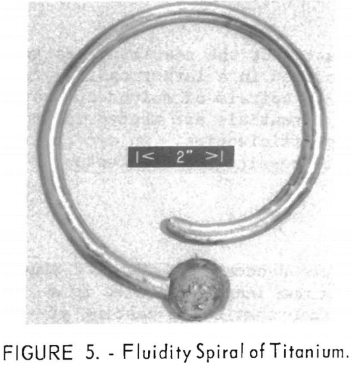 Melting & Casting Titanium
Melting & Casting Titanium
Titanium can be satisfactorily melted and cast using 8 to 10 gallons of cooling water per minute to the ladle, an arc current of 3,000 to 3,500 amperes, and an arc potential of 30 volts. From table 1 it will be noted that run 3 was made using only 3 gallons per minute of water on the ladle and that at this low value the ladle failed. A comparison of runs 1 and 4 indicates that an increase in arc current from 2,200 to 3,000 amperes produces a greater increase in casting efficiency than is achieved by decreasing the coolant flow from 8 to 4 gallons per minute as in runs 2 and 4.
Figure 5 shows the surface markings of a fluidity spiral of titanium produced in heat 7 of table 1. The runner length is 21 inches. The mold for this casting was machined graphite, as were all the molds used for the heats described.
Zirconium Melting & Casting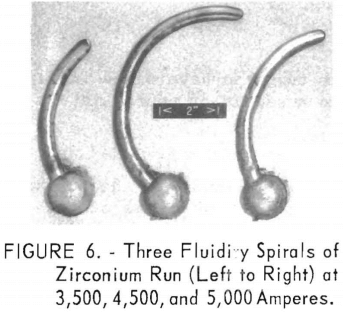
Zirconium is melted and cast satisfactorily under nearly the same conditions as titanium; however, high arc currents (3,500 to 4,500 amperes) are required for melting and casting zirconium. Figure 6 shows three fluidity spirals cast at arc currents of 3,500, 4.500, and 5,000 amperes. Maximum casting efficiency and fluidity were obtained with an arc current of 4,500 amperes. Arc potential was maintained at 32 volts and coolant flow at 15 gallons per minute for all three runs. These three are included as heats 9, 15, and 14 of table 1.
Hafnium Melting & Casting
Because of the scarcity of hafnium metal, few heats have been made, and these have used electrodes formed from bars of pressed turnings. When these runs were undertaken, 4,000 amperes was the limiting arc current available. Experience with other metals indicates that casting efficiencies can be increased by operating at higher arc currents, but no such heats have been attempted with hafnium even though the furnace is now equipped to operate at arc currents up to 8,000 amperes.
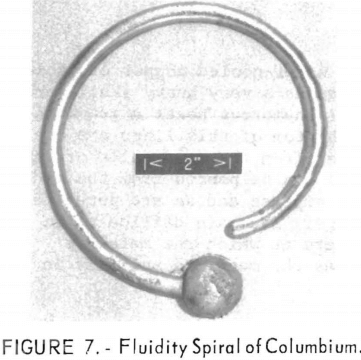 Melting & Casting Columbium
Melting & Casting Columbium
Columbium shows considerable promise as a metal to which this casting process can be applied. Run 4 of table 2 indicates the excellent casting efficiency obtained when columbium is melted at higher power levels.
Figure 7 is a photograph of the fluidity spiral cast in this run. The runner of this spiral was 18 inches long-only 3 inches shorter than the best titanium runner produced. The electrode for this heat was a sintered and forged powder metal compact.
The cast columbium was ductile, and the surface of the casting was excellent. Additional casting heats are necessary to verify reproducibility of the results obtained in this run.
Melting & Casting Molybdenum
Molybdenum can be readily arc melted and cast, but the resulting castings are extremely brittle. Centrifugal castings produced in a larger casting furnace were reported to be more ductile. Fluidity spirals of molybdenum have been produced with 11-inch runners. Higher arc potentials are needed to produce high melting rates and, hence, high casting efficiencies. An arc current of 4,500 amperes and an arc potential of 38 volts results in satisfactory casting efficiency.
Casting Melted Tantalum
Of seven attempts to cast tantalum, five were successful. Table 2 summarizes the results of six of the runs. The maximum length achieved in a fluidity spiral was 12 inches. These castings show that shape casting of tantalum is feasible; however, additional work on both crucible design and mold materials is necessary to decrease the possibility of crucible failure and to improve casting quality.
Melting & Casting Tungsten
Nearly all of the numerous attempts to cast tungsten have ended in failure of the crucible liner. Only one run yielded a sample of poured metal.
Melting & Casting Chromium
A limited number of chromium castings have been produced in the furnace to check the applicability of the process to this metal and others of high vapor pressure. All of the castings have been melted and cast in a helium atmosphere at an absolute pressure of 10 inches of mercury. Heats 10 through 12 of table 3 give the results of three chromium runs. The castings produced in these heats were not evaluated, but it was noted that their grain size was smaller than that of arc-melted ingots.
Melting & Casting Copper
Copper is difficult to melt and cast in a water-cooled copper crucible because the high heat conductivity of copper causes a very heavy skull to be formed; hence, casting efficiencies are low. In numerous heats a graphite liner was placed in the ladle. The walls and bottom of this liner are one-fourth inch thick and insulate the molten copper from the cold walls of the ladle. With this arrangement, all of the metal can be poured from the ladle and no skull remains. An arc current of 3,000 amperes and an arc potential of 25 volts provide satisfactory copper castings. The main difficulty in casting copper is the lack of control of the rate at which the metal is poured, as any delay in the pouring cycle causes the metal to solidify in the ladle.
Melting & Casting Iron
A number of mild steel castings have been produced using electrodes fabricated from commercially available hot-rolled steel rod. This rod is not a satisfactory material for electrode stock because its high content of dissolved gases causes low casting efficiencies and porous castings.
Runs 5, 6, and 7 of table 3 utilized electrode stock prepared from iron-uranium alloys which had been vacuum arc melted before the casting heat. Heats 8 and 9 were run using electrode stock of identical composition; however, the stock had not been vacuum melted before the casting heat. A comparison of casting efficiencies for these five heats indicates that efficiency is higher when the electrode stock has been vacuum melted.
Melting & Casting Metal
Experience with this furnace has shown the need for numerous improvements to increase its usefulness and ease of handling. The ladle and ladle arms have already been modified from the original design to provide increased waterflow to the ladle. The original arms were constructed of 1-inch copper pipe; the arms described in this paper are 1-¼ inches and give a flow of 50 gallons per minute with a line pressure of 60 p.s.i.
This flow provided adequate cooling for melting tantalum, but ladle failure occurred on nearly every tungsten heat attempted. It is questionable if increased waterflow would prevent ladle failure during tungsten heats, but this factor should be considered if additional attempts are made to cast tungsten.
A suggested improvement for the furnace is the enlargement of the mold chamber. The chamber has been adequate for much of the research, but on several occasions the small size of the chamber has seriously limited the versatility of the equipment. A larger chamber would provide the necessary room for properly designed molds. It would also be convenient if access to the mold could be gained from the front of the furnace, so that the molds could be positioned and removed without lowering the chamber from the furnace body.
The furnace could be improved by the use of a one-piece liner for the ladle. The brazed joint between the bottom of the liner and the walls was a weakness. On several occasions the ladle failed during a tungsten heat, but no holes have been found in the liner after the melt cooled. It is possible that the brazed joint parted during the melting and sealed when the run was terminated.
In conclusion, design and operational techniques have been presented for a laboratory-scale arc-casting unit. The versatility of the equipment has been demonstrated by the form and variety of material melted. The equipment should be particularly useful for producing metallurgical specimens where homogeneity in cast material would be beneficial. As many industrial and college laboratories have or plan to install cold-mold arc furnaces, the fact that the casting equipment can be only a modification of a conventional furnace is a definite advantage.
